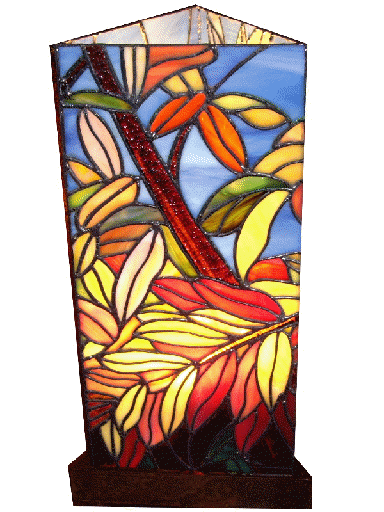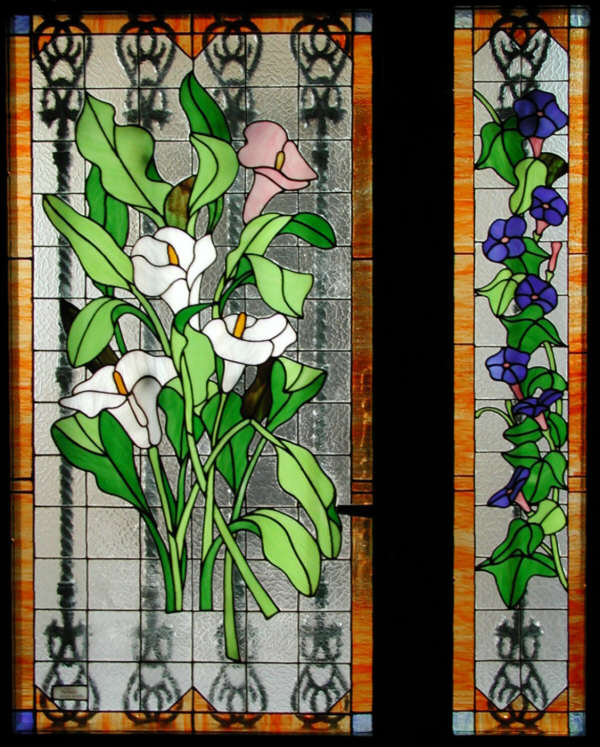
|

|
|
The technique developed by
Tiffany (*)
to make
lamps, stained-glass windows (vitraux) and other decorative items and ornaments using varieties of colors and
textures of glass, combines light with color to obtain unique and beautiful pieces. Its realization is a creative process where sometimes
the design can be much more exciting than the making of the object
itself. (*) 1848-1933 Louis Comfort Tiffany |
 |
__________________________ This section includes some works
developed and made in our private workshop to show an artwork with a technique that is available to everyone.
|
|
The mixture of different types of glass can be very appealing, and, what is most interesting, it is possible to experiment with varied compositions, shapes and colors.
|
 |
 |
If you do not want to complicate your life using molds which are expensive and sometimes hard to find, you can resort to the simple geometric shapes of flat faces and facets to obtain very interesting results.
|
 |
 |
|
The work for implementation can be as complicated as you want ... |
... or as simple as one would like. |
|
For lamps with semi-spherical or other non-flat shapes it will be convenient to work using patterned fiberglass molds or paper patterns, which can be purchased in specialized stores or constructed by oneself.
|
 |
 |
 |
|
Let your imagination
run wild. |
...and a table clock that usually works perfectly.
|
![]()
|
From Plato to Archimedes or how to make a soccer ball. |
|
Polyhedra are flat sided geometric figures and finite volume. Of the different families The most complex of them, having the largest number of faces (20), is the
icosahedron
made up of 20 equilateral triangles. |

Icosahedron |
|
Effect of truncating the icosahedron |
|
|
By
intersecting or cutting the vertices of an icosahedron (as depicted
above) it is possible to obtain the shape of a truncated
icosahedron, with 32 faces consisting of 12 pentagons and 20
hexagons.
|
|
|
|
Actually, other solids further approach the shape of a sphere. One of them is the rhombicosidodecahedron, another Archimedean solid, with 62 faces and formed by 20 triangles, 12 pentagons, 30 squares with 120 edges and 60 vertices. If a figure is constructed with this number of faces it could conform a ball that fills over 94% of a sphere of equivalent diameter, reaching almost 99% when inflated. An almost perfect sphere.
|
Rombicosidodecahedron |
|
|
![]()
|
DIFFERENT TYPES OF GLASS |
Prism shaped lamps in triangular base.
 |
 |
|
In any case, many lamps "look" as much when switched off...
|
... or when lit.
|
|
Three views of the same lamp (prismatic of triangular base) on a mounting made of a "slice" of olive tree trunk that was properly treated, polished and lacquered. The lamp can be rotated at will if you get tired of seeing the same face (rose, calla lily or pansies). |
|
|
|
The metal housing of this lamp was rescued from a landfill site. It was a lamp, which with its paraffin oil burner and dim light, illuminated a railway station in the early last century. Dented, dirty and covered with rust, was subjected to a careful and thorough cleaning to remove dirt - including a nest of wasps - restored, painted and varnished. In our workshop we made three naďf designs for the three sides of the lamp (40 x 25 cm). The end result can be seen in the images. The lamp lights now our summer dining terrace. |
Some other works and designs.
 |
 |
 |
 |
 |
With a little imagination any motif may be valid for making butterflies, wall lights, different types of lamps, etc. |
The workshop.
|
The workshop has a well-lit space with some specific tools (glass cutters, cutting pliers,
grinder accessories and polishing wheels, copper foil of different
widths, 80 W soldering, tin, drawing tools, scissors etc.). |

|
![]()
Some recent work.
Cascading grape lamp
|
|
Here
we work in the construction of a lamp, 70 cm. in diameter and 30 cm. high, with eight triangular panels
and a circular skirt.
|
|
Seeking the widest possible range, we preferred to use various colors for the
different leaves, rather than perform them in a uniform color, although this does not conform to
reality. Just glorious! |
|
 |
|
A mirror between flowers and plants.
 |
We made a 45 cm side square
mirror bordered by a frame of leaves and flowers on 10 mm thick board. Once designed the pattern of the different parts, including all 4 mm. thick mirror pieces, they were edged with copper foil of 4.5 mm. All glass pieces, including the mirror ones, stick with special silicone on the board. With the parts attached to the welding table soldering gives no problems remaining firmly held together on the board. |
|
Assembling and gluing the pieces of the mirror on the board. |
|
The mirror was finally framed choosing a suitable molding.
|

|
![]()
|
There are many other reasons on which to express creativity in works of art that combines the magic of light and color, for example: GLASS WINDOWS. |
|
|
We perform a
glass window to be installed in the front door. |
|
After
completing the work, we proceed to a
thorough and
complete cleaning by removing all traces of resin and
dirt.
|

|
 The finished work.
The finished work.
As seen from inside the hall... |
|
 |
To the left is another glass window to accompany on an interior door. It is made on translucent and opal glass with fruit motifs.
|